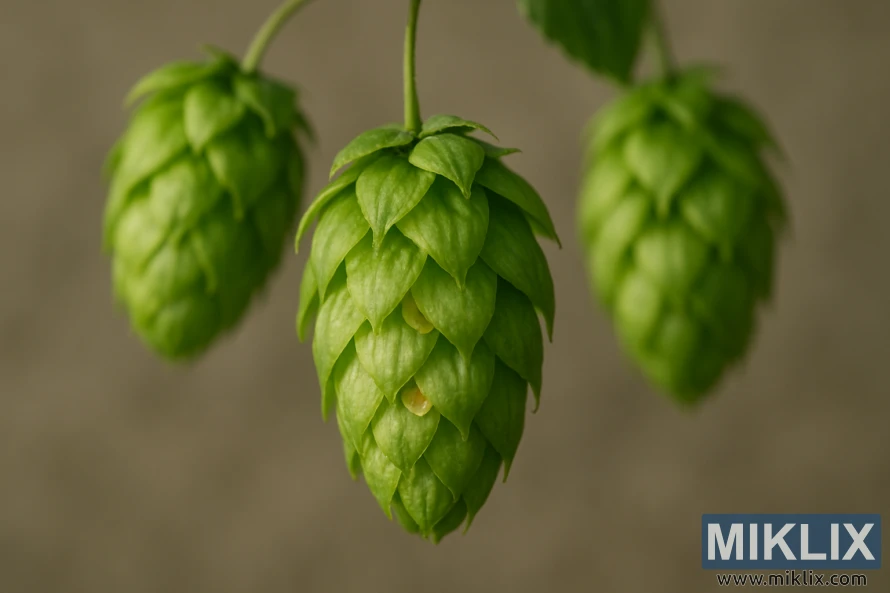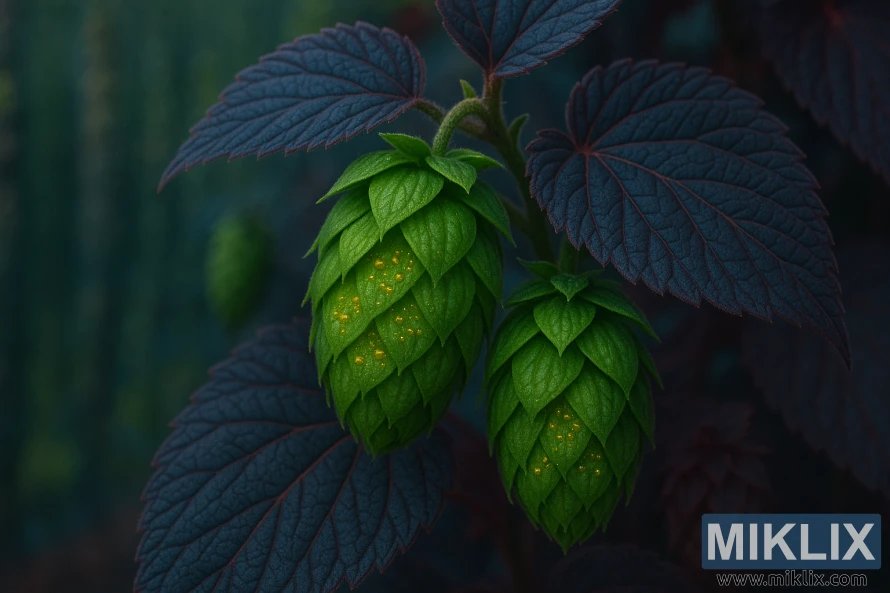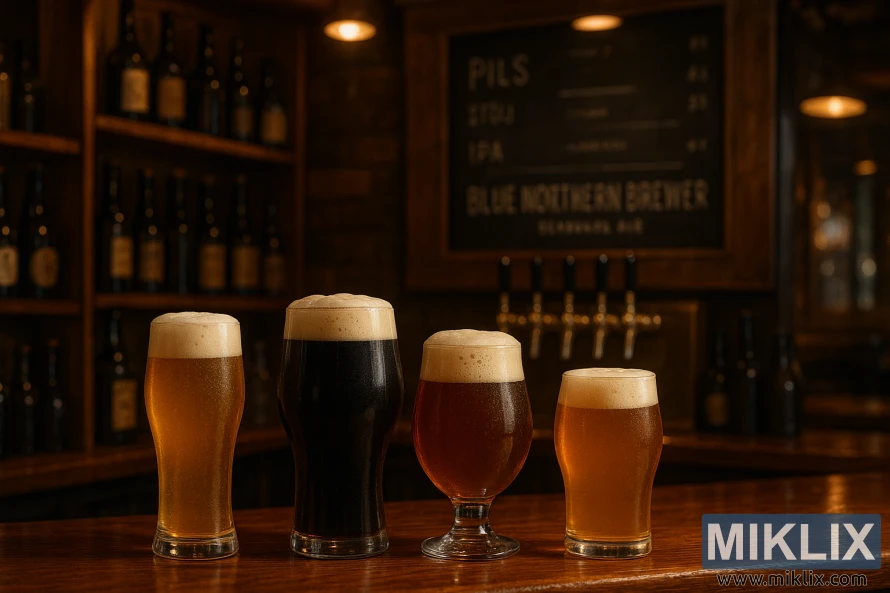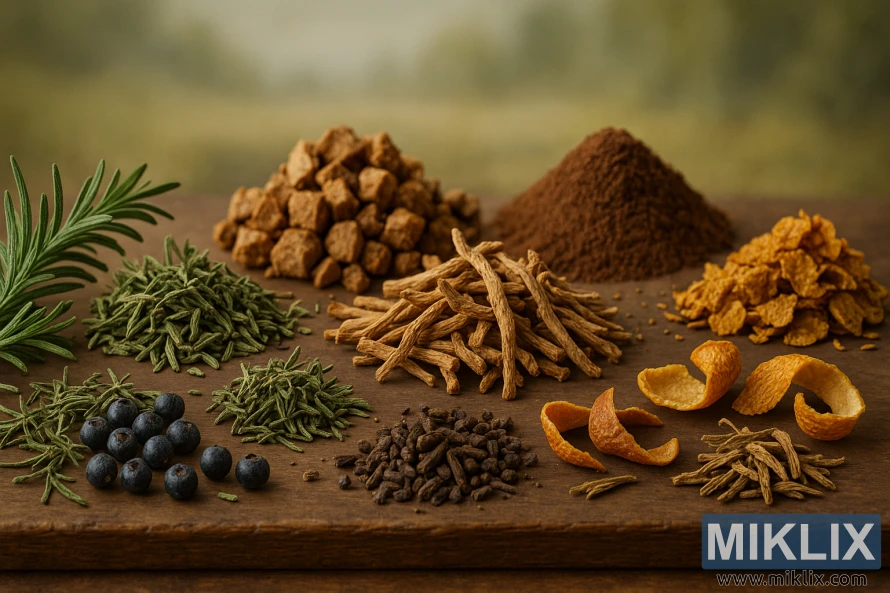Hops in Beer Brewing: Blue Northern Brewer
Published: August 1, 2025 at 9:34:21 AM UTC
The Blue Northern Brewer hop variety has a unique history. It was discovered as a mutant with deep reddish-blue leaves in a Belgian hop yard in the early 1970s. This distinctive hop has caught the attention of brewers. It offers a chance to explore new flavors and aromas in beer brewing.The development of Blue Northern Brewer Hops has broadened our understanding of hop varieties. This knowledge is invaluable for brewers looking to experiment and innovate.

Key Takeaways
- Blue Northern Brewer Hops were discovered in a Belgian hop yard.
- They offer unique characteristics for beer brewing.
- Their development has expanded the range of hop varieties.
- Brewers can experiment with new flavors and aromas.
- Their history and characteristics are of interest to brewers.
The Origin Story of Blue Northern Brewer Hops
Blue Northern Brewer hops were first introduced as an ornamental variety, marking the beginning of their journey in the brewing world. Originating from a Belgian hop yard, their discovery paved the way for their later use in brewing. The year 1992 was significant for Blue Northern Brewer hops as they were officially released as an ornamental variety, showing their promise beyond mere decoration.
The development of Blue Northern Brewer hops involved careful cultivation and selection, highlighting the importance of hop breeding programs. Their introduction into the brewing scene was met with interest due to their unique characteristics. Brewers could leverage these to create distinct beer profiles.
The journey of Blue Northern Brewer hops from a Belgian hop yard to becoming a recognized hop variety in brewing is a testament to the evolving nature of hop cultivation and beer brewing. As brewers continue to experiment with different hop varieties, understanding the origins and characteristics of hops like Blue Northern Brewer becomes essential.
Understanding Blue Northern Brewer Hops Characteristics
For brewers aiming to craft specific beer styles, grasping the properties of Blue Northern Brewer Hops is key. These hops boast a unique profile, with alpha acids ranging from 6% to 8% and beta acids from 3% to 4%. This balance is vital for the beer's bitterness and flavor stability.
The physical attributes of Blue Northern Brewer Hops, such as cone size and density, also impact brewing techniques. Larger cones might necessitate adjustments in hop processing, influencing the brewing process. The chemical makeup of these hops further shapes the beer's aroma and flavor, making them versatile for various beer styles.
- Alpha acid content: 6%-8%
- Beta acid content: 3%-4%
- Cone size and density: Influences hop processing and brewing techniques
By comprehending these characteristics, brewers can optimize the use of Blue Northern Brewer Hops in their recipes. This knowledge is essential for both traditional and experimental brewing, enabling a broad spectrum of beer styles to be created.

Essential Aroma and Flavor Profile
Blue Northern Brewer Hops stand out with their complex aroma and flavor profile. They are a key ingredient in many beer styles. Their unique taste is often described as lemony zest with hints of Chinook, making them a fascinating choice for brewers.
The sensory characteristics of Blue Northern Brewer Hops greatly enhance a beer's overall character. Their distinct aroma adds complexity, while their flavor profile brings depth and nuance.
In brewing, Blue Northern Brewer Hops are versatile, suitable for a range of beer styles. From crisp lagers to complex ales, they offer brewers a chance to innovate and experiment with new recipes.
Understanding the aroma and flavor profile of Blue Northern Brewer Hops opens up new possibilities for brewers. They can use these hops to create distinctive and memorable brews, leveraging their unique characteristics.
Chemical Composition and Properties
For brewers, grasping the chemical properties of Blue Northern Brewer Hops is critical. These hops boast a unique chemical makeup. This contributes to their bittering and aroma qualities.
The chemical composition of Blue Northern Brewer Hops includes a co-humulone content of about 24%. Co-humulone is a part of alpha acids, vital for beer bitterness. A moderate co-humulone level, as seen in Blue Northern Brewer Hops, results in smoother bitterness.
The total oil composition of Blue Northern Brewer Hops is roughly 0.76 mL/100g. The oil content is significant, shaping the hop's aroma and flavor. The specific oils present can vary, affecting the beer's overall character.
The alpha and beta acid content in Blue Northern Brewer Hops are key to their brewing value. Alpha acids mainly contribute to bitterness. Beta acids, on the other hand, enhance flavor and stability in the beer.
- The co-humulone composition affects the bitterness quality.
- Total oil content influences the aroma and flavor.
- Alpha and beta acids are critical for bitterness and beer stability.
Brewing chemistry is complex, and understanding the properties of ingredients like Blue Northern Brewer Hops is essential. By analyzing the chemical composition, brewers can make informed decisions about hop usage and beer formulation.
Brewing Applications and Techniques
The popularity of Blue Northern Brewer Hops in brewing is on the rise. This is due to their unique bitterness and flavor. They are ideal for brewing where a subtle bitterness and distinct flavor are sought.
Effective use of Blue Northern Brewer Hops in brewing requires understanding their alpha acid content. This content, typically between 8-12%, makes them versatile. They can be used in both bittering and flavor/aroma additions.
When using Blue Northern Brewer Hops in beer recipes, brewers can tap into their earthy and spicy notes. This can lead to complex and balanced brews. Some recommended techniques include:
- Using Blue Northern Brewer Hops as a bittering hop to add depth to the beer.
- Incorporating them into the flavor/aroma hop blend to enhance the beer's complexity.
- Experimenting with different hop addition times to achieve the desired balance of bitterness and flavor.
By mastering these techniques, brewers can fully exploit Blue Northern Brewer Hops. This results in distinctive beers that can stand out in the market.
Compatible Beer Styles and Recipes
Blue Northern Brewer Hops are perfect for brewers aiming to create specific beer styles. They work well with malts that don't overshadow them. This makes them ideal for beers where a gentle bitterness is needed.
These hops are versatile, fitting into various beer styles from traditional ales to lagers. Their mild flavor complements other ingredients without dominating them. Choosing the right malt and yeast is critical to achieving the desired flavor.
Choosing the right malt is essential for brewers. Malts that are too strong can clash with the hops, while too mild ones may get lost. A balanced malt profile is vital for a harmonious beer. The yeast choice also impacts the final product, as different yeast strains can enhance or diminish flavors.
Some popular beer styles that use Blue Northern Brewer Hops include:
- English-style ales, where the hops add a subtle bitterness and complexity.
- Lagers, where they contribute to a clean, crisp flavor profile.
- Pale ales, where the hops enhance the beer's hoppy character without overwhelming it.
When crafting recipes with Blue Northern Brewer Hops, brewers must consider the beer's overall balance. The hops' alpha acid content and flavor profile should complement the other ingredients. This approach allows brewers to create a wide range of beer styles that highlight these hops' unique qualities.

Storage and Handling Best Practices
To keep Blue Northern Brewer Hops in top condition, it's vital to follow best practices for storage and handling. These hops are prized for their high alpha acid content, a key factor in brewing. The right storage conditions are essential to preserve these acids.
Research shows that Blue Northern Brewer Hops retain 78% of their alpha acid after 6 months at 20ºC (68ºF). This underlines the need for controlled storage environments. Here are some key considerations for storing and handling Blue Northern Brewer Hops:
- Store hops in a cool, dry place, away from direct sunlight and heat sources.
- Use airtight containers or packaging that minimizes exposure to oxygen.
- Keep the storage area clean and free from contaminants and moisture.
- Monitor storage conditions regularly to ensure consistency.
Effective hop handling is also critical. This includes:
- Handling hops gently to avoid damage and loss of lupulin.
- Minimizing exposure to air during packaging and storage.
- Using frozen storage for long-term preservation, as it significantly slows down the degradation process.
By sticking to these best practices, brewers can keep their Blue Northern Brewer Hops fresh and effective. This ensures the quality and consistency of their beers. Whether you're a homebrewer or a commercial brewery, proper storage and handling are essential to unlock the full flavor of these versatile hops.
Common Substitutes for Blue Northern Brewer Hops
When Blue Northern Brewer Hops are not available, brewers can turn to several alternative hop varieties. Chinook is a notable substitute, known for its high alpha-acid content and robust flavor profile.
Other brewing alternatives include Northern Brewer and Galena hops. Both share similarities with Blue Northern Brewer Hops in terms of their bittering properties. Northern Brewer hops have a woody and minty flavor. Galena hops are known for their clean bitterness.
In various beer styles, these substitutes can be used to achieve the desired bitterness and flavor profiles. For example, in IPAs and pale ales, Chinook or Galena hops can be used to add a robust bitterness. They also bring a hint of spice or fruitiness.
When substituting Blue Northern Brewer Hops, brewers should consider the specific characteristics of the alternative hop varieties. Adjusting their recipes is necessary to achieve the desired beer styles.
- Chinook: High alpha-acid content, robust flavor profile
- Northern Brewer: Woody and minty flavor
- Galena: Clean bitterness

Brewing Tips and Troubleshooting
To maximize the use of Blue Northern Brewer Hops, brewers should aim for simplicity and balance in their recipes. Keeping the International Bitterness Unit (IBU) low is key. This allows the hops' subtle bitterness to enhance the beer's smoothness and refinement.
Several tips can enhance the brewing process with Blue Northern Brewer Hops:
- Adopt a straightforward hopping schedule to preserve the beer's delicate flavor.
- Keep a close eye on the beer's bitterness, as these hops can quickly overpower if used excessively.
- Ensure the hops complement the other ingredients, maintaining the beer's overall balance.
Addressing common issues is essential when using these hops. If the beer becomes too bitter, adjusting the hopping rate or timing can correct it. On the other hand, if the bitterness is lacking, adding more Blue Northern Brewer Hops in future batches can solve the problem.
Optimizing brewing techniques for Blue Northern Brewer Hops requires patience and experimentation. By grasping the unique traits of these hops and applying the correct strategies, brewers can craft distinctive, premium beers. These beers will highlight the hops' subtle flavors and aromas.
Comparing Fresh vs. Aged Blue Northern Brewer Hops
Blue Northern Brewer Hops, whether fresh or aged, bring unique qualities to brewing. The difference between fresh and aged hops is key for brewers. It greatly affects the beer's flavor, aroma, and quality.
Fresh Blue Northern Brewer Hops are celebrated for their lively flavor and aroma. They have a higher concentration of essential oils, which enhance the beer's aroma and taste. Using fresh hops in brewing can add a more intense bitterness and a richer hop flavor.
On the other hand, aged Blue Northern Brewer Hops undergo a natural degradation. This process changes their chemical makeup. Aged hops tend to lose some bitterness and aroma, leading to a smoother, more subtle taste. This makes them perfect for brewing where a milder hop flavor is needed.
The choice between fresh and aged Blue Northern Brewer Hops depends on the brewer's goals and the beer style. Here are some key considerations:
- Fresh hops are ideal for beers where a robust hop flavor and aroma are desired, such as IPAs and pale ales.
- Aged hops are better suited for beers where a subtle hop character is preferred, such as lagers and amber ales.
- The age of the hops can also impact the beer's bitterness level, with fresh hops contributing more bitterness than aged hops.
Understanding the differences between fresh and aged Blue Northern Brewer Hops helps brewers make better hop choices. This affects the quality and character of their beers.
Commercial Brewing Applications
Blue Northern Brewer Hops have become essential in commercial brewing. Their unique flavor and aroma profile set them apart. In large-scale brewing, they add depth and complexity to various beer styles.
Commercial breweries use Blue Northern Brewer Hops to craft distinctive beers. These hops are perfect for brewers aiming to innovate and differentiate their products. Their unique characteristics make them a go-to choice.
The versatility of Blue Northern Brewer Hops is unmatched. They excel in bittering, flavor, and aroma additions. Their high alpha acid content is ideal for bittering. Their unique flavor and aroma make them perfect for adding depth to beers.
- Enhancing the flavor and aroma of beer with unique characteristics
- Adding depth and complexity to various beer styles
- Providing a versatile ingredient for brewers to experiment with
Commercial breweries can tap into a wide range of beer styles with Blue Northern Brewer Hops. Whether for bittering, flavor, or aroma, these hops are invaluable. They enrich any brewery's ingredient portfolio.
Homebrewing with Blue Northern Brewer Hops
Homebrewers looking to deepen their brews will find Blue Northern Brewer Hops a valuable asset. These hops bring a subtle bitterness and a rich flavor, perfect for various beer recipes. They are a traditional choice for adding depth to your brews.
Understanding the characteristics of Blue Northern Brewer Hops is key when using them in homebrewing. Knowing how they interact with other ingredients is essential. This knowledge will help you refine your brewing techniques and create unique beers.
Here are some tips for homebrewers working with Blue Northern Brewer Hops:
- Use Blue Northern Brewer Hops as a bittering hop to add depth to your beer recipes.
- Experiment with different boil times to optimize the hop's unique flavor and aroma characteristics.
- Combine Blue Northern Brewer Hops with other hop varieties to create complex and balanced flavor profiles.
By mastering the use of Blue Northern Brewer Hops in homebrewing, you can develop unique beer recipes. These recipes will showcase the hop's distinct qualities and enhance your overall brewing techniques.
Sustainability and Environmental Impact
Blue Northern Brewer Hops are not just prized for their brewing qualities. They also play a key role in reducing environmental impact. As breweries move towards sustainable practices, these hops are essential in lowering ecological footprints.
The cultivation of Blue Northern Brewer Hops contributes to sustainable brewing in several ways. Firstly, they are known for their hardiness and resistance to diseases. This reduces the need for pesticides and chemicals. It makes the cultivation process greener and results in a cleaner product for brewing.
Using Blue Northern Brewer Hops efficiently also helps reduce waste in brewing. By optimizing hop usage, breweries can cut down on waste. This minimizes their environmental impact.
To maximize the sustainability benefits of Blue Northern Brewer Hops, breweries can adopt several practices. These include:
- Implementing hop recycling programs
- Using hop extracts or pellets to reduce waste
- Optimizing brewing recipes to maximize hop flavor while minimizing usage
By embracing these practices, breweries can enhance their sustainability credentials. They contribute to a more eco-friendly brewing industry as a whole.
Conclusion
Blue Northern Brewer Hops have emerged as a key ingredient in beer brewing, bringing a unique flavor and aroma. They are perfect for brewers aiming to craft complex and intriguing beers. Their distinct characteristics make them a top choice for those looking to create unique brews.
The use of Blue Northern Brewer Hops can lead to exceptional beers with depth and nuance. Brewers can tap into their full flavor by understanding their chemical makeup, brewing techniques, and storage methods. This knowledge unlocks the full range of possibilities these hops offer.
As the brewing industry grows, focusing on sustainable and environmentally friendly practices is vital. Using ingredients like Blue Northern Brewer Hops sustainably is essential. This approach not only ensures high-quality beers but also supports a greener brewing process.
In conclusion, Blue Northern Brewer Hops are a valuable asset for brewers. They open up a world of possibilities for creativity and innovation in brewing. Their unique qualities make them a must-have for any brewer looking to push the boundaries of their craft.
Further Reading
If you enjoyed this post, you may also like these suggestions:
